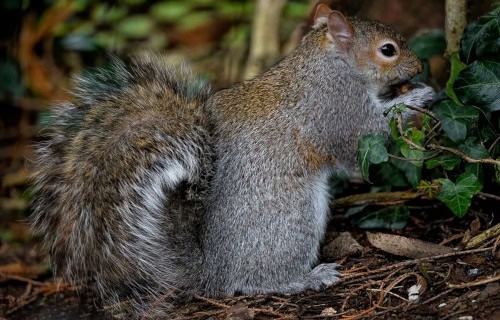
We hope that each of you, our readers, will enjoy and appreciate this article we present about these 5 Fabulous Mammals of Florida. It was certainly our pleasure to compile the information for you. May it provide you with both education and increased awareness.
These few species listed herein represent only a portion of the natural wonders found throughout the region, though. Yet, it’s our belief that they serve as excellent representations of the wonders found here. Check out some of our other articles for similar marvels.
Striped Skunk
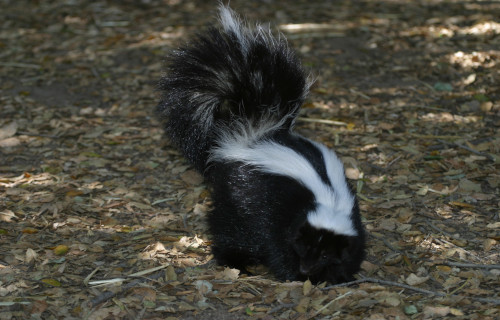
Striped Skunk Facts
- Starting off this article about these 5 Fabulous Mammals of Florida we present to you the oft-maligned Striped Skunk.
- This beautiful small mammal with the unfortunate reputation most frequently goes by the common name that we use here. It does have a few other general monikers, though. Those include common skunk, northern skunk, and prairie polecat.
- Within the scientific community, however, it’s typically referred to by its technical title. That, thankfully is a relatively simple name for the layperson to pronounce. That’s true since the animal bears the official moniker of the Mephitis mephitis.
- The creature received that distintictive formal title due to the efforts of the German naturalist, Johann Christian Daniel von Schreber. He accomplished the first acknowledgement of it as a separate and distinct species. That occured in 1776.
- Regardless of which appellation one uses, it remains one of the most easily recognizable animals in its native range. It’s even become immersed in the local culture, appearing as a character in various cartoons. A total of 13 subspecies also exist.
- Fortunately, the remarkable Striped Skunk seems to be maintaining a sizeable and stable population base. That pleasant trend further appears to hold true throughout the entirety of its habitat zone. The IUCN, therefore, now lists it as Least Concern.
- The intriguing creature nevertheless faces some very real potential threats to its continued existence as a species. In this, it’s in the same situation as most species. It’s endangered by the dual perils posed by habitat loss and ongoing climate change.
Striped Skunk Physical Description
The remarkable Striped Skunk presents the viewer with a captivating appearance. It fully deserves appreciation for the beauty Nature gifted it with. It’s not an overly large animal, in terms of pure physical size. Nature, however, blessed it with other attributes.
Like many fauna, the mammal presents a certain degree of the physiological characteristic of sexual dimorphism. In its specific case, this trait manifests itself in terms of sheer physical measurements. Due to that tendency, males attain a larger size than females.
That difference remains minor, though. As a general principle, the males grow to about 10% larger than their female counterparts. This includes both weight and length of body. Exceptional individuals do naturally occur, however, completely regardless of their gender.
Overall, individuals attain an average head-to-tail length equaling between 20.5 – 30.3 in (52 – 77 cm). Body mass also varies accordingly. Specimens therefore typically display weights ranging from 4 – 9.9 lb (1.8 – 4.5 kg). Some do reach as much as 12 lb (5.5 kg), though.
The body of the Striped Skunk is perhaps best described as stout. It’s limbs develop as relatively short, while it has a small, conical head. The thickly-furred tail usually accounts for about half the overall length. The front feet have long claws, but the rear one’s are shorter.
Yet its the color pattern of the animal that catches the eye first. The precise nature of this varies widely between individuals, but a basic pattern remains. That generally consists of a deep black background, with the well-known white stripe extending from nose to tail tip.
- Kingdom: Animalia
- Phylum: Chordata
- Class: Mammalia
- Order: Carnivora
- Family: Mephitidae
- Genus: Mephitis
- Species: M. mephitis
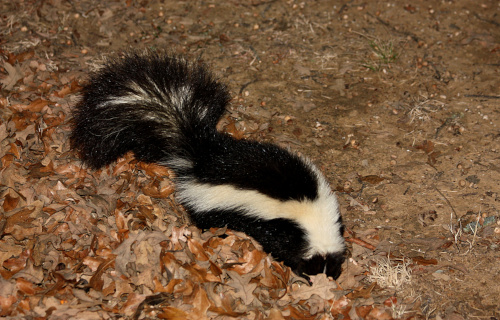
Striped Skunk Distribution, Habitat, and Ecology
The beautiful Striped Skunk evolved as endemic to a comparatively wide expanse of the world. That precise region of the globe doesn’t surprise many people, however. That’s because it developed as endemic to much of what’s now known as North America.
The majority of its natural zone of habitation includes the entirety of the continental United States. To the north, though, it appears in the approximate southern half of the country of Canada. Southerly, the oft-maligned animal lives in a small part of northern Mexico.
Nature blessed this natural marvel with an impressive adaptability in terms of its habitat choices. Due to that flexibility, it appears in a wide range of ecosystems. These include such diverse regions as rocky outcrops, wooded ravines, and moderately brushy corners.
It does, however, show a moderate preference for areas of mixed woodlands. Its adaptability never ceases to amaze, though. As a result of human presence, in some regions, such as the state of Illinois, a few populations actually prefer cultivated areas to uncultivated.
It’s the defensive tactics of the Striped Skunk that gathers the most attention. Two glands near the base of the tail produce an extraordinarily odorous liquid. The animal can spray this at will for a respectable distance. Due to the strength of this, it has few predators.
It’s mainly carnivorous in terms of diet. The animal mostly feeds on insects, such as grasshoppers, crickets, beetles, and caterpillars. Yet, it sometimes eats eggs, voles, mice, as well as fish and small reptiles. Various fruit, such as berries, also form an occasional treat.
West Indian Manatee
West Indian Manatee facts
- Here in this compilation of 5 Fabulous Mammals of Florida comes the only marine species among them, the West Indian Manatee.
- The informative term applied to it serves as the most frequently employed name for this marvel of Nature and evolution. It does have another, less often used title, though. That’s the equally informative term of North American Manatee.
- Among scientific professionals, however, it’s generally referred to by its technical moniker. Luckily for the layperson, that’s a comparatively simple to pronounce term. That’s because this marvelous mammal bears the formal title of Trichechus manatus.
- The magnificent animal received that relatively short title due to the efforts of Carl Linnaeus. The esteemed Swedish zoologist accomplished the first official recognition of it as a separate and distinct species. He managed this feat in the year 1758.
- No matter which of these various names one uses, though, it remains a remarkable species. That’s partly due to the fact that it’s the largest known member of its Order, the Sirenians. Two acknowledged subspecies of the animal also remain extant.
- Presently, the population base of the West Indian Manatee continues to rebound, albeit slowly. That fortunate trend also appears to hold true throughout the entirety of its range. Prior to protective actions, the IUCN listed it as Endangered on its Red List.
- Due to a small but steady rise in numbers since those actions, it now lists as Vulnerable. The remarkable mammal nevertheless still faces numerous threats to its existence. These include such factors as habitat loss, and the looming danger of climate change.

West Indian Manatee Physical Description
The stunning West Indian Manatee quickly impresses those lucky enough to encounter one in the wild. The distinctive creature does so, however, for a variety of reasons. Though certainly not the only reason, of course, its sheer size nonetheless ranks as one of them.
Like most mammals, it also displays a certain amount of the physiological characteristic known as sexual dimorphism. In its specific case, this trait manifests itself in terms of physical dimensions. More specifically, females attain a larger average size than males.
The difference generally remains minor, though. It’s therefore typically difficult for untrained observers to distinguish the two genders. As a general principle, individuals achieve an impressive size, regardless of gender. Exceptional specimens of both sexes also occur.
It additionally develops a largely streamlined body shape. Being fully aquatic in nature, the creature possesses no hind limbs. But, in their place, the remarkable Sirenian develops a broad, spatula-like tail. It also has a short, yet prehensile snout, similar to an elephant.
Overall, mature adults reach lengths averaging between 8.9 – 11.5 ft (2.7 – 3.5 m). Weights also vary between individuals, with females naturally usuallybeing the heavier. The adults usually range in weight from approximately between 440 – 1,320 lb (200 – 600 kg).
Those same exceptional specimens sometimes attain masses of as much as 3,649 lb (1,655 kg). Except for such rare cases, both genders of the West Indian Manatee appear the same. Normally, the color of the skin presents as an overall brown and gray mixture.
Their appearance still varies, though. This occurs due to several reasons. Algae and barnacles both frequently attach themselves to large portions of the body. Many specimens also develop scars from conflicts. These show white, and often remain for decades.
- Kingdom: Animalia
- Phylum: Chordata
- Class: Mammalia
- Order: Sirenia
- Family: Trichechidae
- Genus: Trichechus
- Species: T. manatus
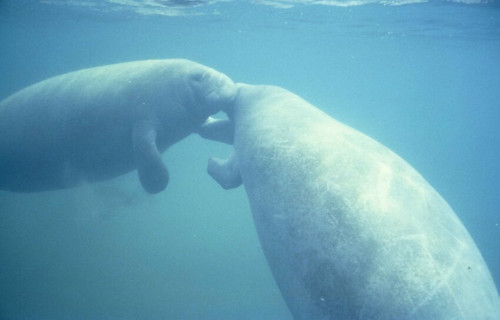
West Indian Manatee Distribution, Habitat, and Ecology
The marvelous West Indian Manatee evolved as endemic to a moderately broad swathe of the marine waters of the world. The name itself provides at least some indication of a portion of that range. It lives in a specific yet restricted portion of the Atlantic Ocean.
As that title implies, the creture seems to be primarily, though not wholly, endemic to the West Indies. Its full range, however, extends from the east coast of the United States to the northeastern tip of South America. It’s currently unknown if it ever lived anywhere else.
The animal further seems to be highly evolved in terms of habitat preferences. Generally, it resides almost exclusively in shallow areas along various coasts. Despite its being a creature of the seas, it also displays a remarkable adaptability in terms of where it appears.
That’s because the animal possesses the ability to handle changes in salinity very well. Thus, the intrepid explore often ventures into areas of fresh water. These include such surprising regions as shallow rivers and estuaries. One once ventured into a river in Tennessee!
As a general principle, the gorgeous West Indian Manatee lives a primarily solitary life. Usually, groups only form during mating season. Sometimes, thouh, such groups come together, apparently coincidentally, in warmer waters during the winter season.
It feeds mainly as a herbivore. In doing so, it consumes over 60 varieties of aquatic plants, and a few small fish and invertebrates. These include both marine and freshwater species. It itself has few known natural predators. These consist of orcas, large sharks, and alligators.
Eastern Gray Squirrel

Eastern Gray Squirrel Facts
- Our next choice for inclusion in the listing of 5 Fabulous Mammals of Florida is the adorable rodent best known as the Eastern Gray Squirrel.
- The informative term given to it here serves as the most frequently used common name for this beautiful product of evolution. The adorable mammal does have another, very similar title, though. That’s the shorter term of the gray squirrel.
- Among scientific professionals, however, it’s generally referred to by its formal title. Unfortunately, that technical moniker remains somewhat difficult for the layperson to pronounce. That’s because it bears the official name of the Sciurus carolinensis.
- The rodent received that tongue-twisting appelation due to the efforts of the German naturalist, Johann Friedrich Gmelin. He accomplished the first acknowledgement of the animal as a separate and distinct species. He managed that deed in 1788.
- No matter which of these monikers one chooses to use, though, it remains an interesting fauna. Despite its small stature, it plays a pivotal role in its region. In fact, the creature represents perhaps the most important regenerator of forests in its range.
- Its therefore fortunate that the Eastern Gray Squirrel seems to be maintaining a population base that’s both stable and sufficient. That pleasant situation also appears to hold true throughout its territory. Accordingly, the IUCN lists it as Least Concern.
- The marvel of Nature nonetheless faces some potential threats to its contiued existence as a species. Most of those, though, mirror the situation of many species. It faces the possible dangers of habitat degradation and loss, and, of course, that of climate change.

Eastern Gray Squirrel Physical Description
The remarkable Eastern Gray Squirrel generally captures the attention and appreciation of those who encounter it. The animal does so for various reasons, of course. Sheer physical measurements, however, rarely factor into the general respect it’s usually accorded.
In that regard, it follows the pattern established by the majority of its kin around the world. That’s true since it displays no noticeable degree of the phsyiological characteristic of sexual dimorphism. The genders, therefore, can be hard for the layperson distinguish simply.
Individuals of both sexes of the animal attain a body length that averages between 9.1 – 11.8 in (23 – 30 cm). The tail, however, grows comparatively long in relation to body size. This appendage typically reaches lengths equaling between 7.5 – 9.8 in (19 – 25 cm).
Weights remain surprisingly light, again among both genders. Mature adults usually reach a mass of between 14 – 21 oz (0.4 – 0.6 kg). Exceptional specimens do occur, of course. These, though, rarely exced either of these categories by more than a minor amount.
In overall appearance, likewise, both genders of the Eastern Gray Squirrel present the same overall patterns. Like all known squirrels, it develops four toes on its front feet, but five on the hind feet. Intriguingly, its teeth commonly grow throughout the life of the rodent.
It’s the coloring of the gorgeous creature that stands out the most, though. The fur usully presents a predominantly light gray shade. Some, however, present a light brown. Its underside shows an off-white hue. Also gray, the tail typically possesses a dense, fluffy coat.
- Kingdom: Animalia
- Phylum: Chordata
- Class: Mammalia
- Order: Rodentia
- Family: Sciuridae
- Genus: Sciurius
- Species: S. carolenensis
Eastern Gray Squirrel Distribution, Habitat, and Ecology
The distinctive Eastern Gray Squirrel evolved as native to a moderate portion of the globe. The precise location of that zone of habitation likely won’t surprise many people, though. That’s true since it developed as endemic to a section of the continent of North America.
Its very name provides a clue into which portion of that greater area it lives, too. As that indicates, the beautiful mammal mainly lives in the general eastern part. Some do live in the midwest, however. It lives from southeast Canada, to Florida and Texas, in the United States.
Though quite adaptible, the impresive animal does show decided preferences in its choice of habitat. The great majority of specimens prefer to make their home in large areas of dense, mature woodland ecosystems. These usually comprise mostly deciduous trees.
Although it does adapt, it nonetheless shows another strong preference for certain varieties of trees. The forests where it makes its home generally contain a large percentage of hickory and oak trees. These regions, can, though, sometimes include larger parks and yards.
Like its relatives, the Eastern Gray Squirrel evolved as herbivorous in nature. Its diet covers a wide range of food sources. These include such things as flowers, tree buds and bark, berries, and seeds. It does show a strong preference for various nuts, which it often saves for later.
It developed as a primarily solitary species. The creature builds its nest in the forks of trees, and the male and female generally only share a nest during breeding season or exceptionally cold periods. It will also make use of dens in trees vacated by former occupants.
Gray Fox
Gray Fox Facts
- Next up in this gathering of 5 Fabulous Mammals of Florida we give you the remarkable canine known as the Gray Fox.
- This somewhat diminutive but still fascinating creation of Nature most frequently goes by the partially descriptive common name due to its appearance. It also has other alternates, though, These include the maned fox, tree fox, and common gray fox.
- Its formal name, however, is significantly harder to pronounce, perhaps even for experienced professionals. That’s because the official term applied to this marvelous mammal in the halls of science is the tongue-twisting term Urocyon cinereoargenteus.
- The visually distinctive species further received this appellation due to the work of the respected German naturalist, Johann Christian Daniel Schreber. He accomplished the first official recognition of the animal as a separate and distinct species, in 1775.
- Intriguingly, from a scientific standpoint, the creature represents one of only two members of its genus, Urocyon. Both it and the other member genetically represent the closest known surving species, out of all known canids, to a common ancestor.
- For the moment, the Gray Fox appears to be maintaining a population base that’s both stable and sufficient. The IUCN, therefore, currently lists it as Least Concern on its Red List. That holds true despite a reduced population in certain portions of its range.
- This marvel of Nature nevertheless faces some potential threats to its continued existence. Habitat loss, largely due to human encroachment naturally presents a problem. The greatest threat it faces, though, likely consists of ongoing climate change.
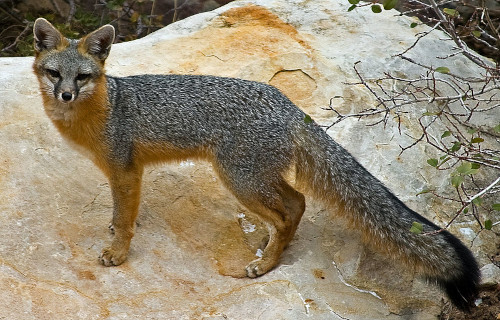
Gray Fox Physical Description
The magnificent animal most frequently known as the Gray Fox manages to pack all this awesomeness into a relatively small body. This merely serves to prove the point that physical size remains wholly irrelevant when considering the impressiveness of a species.
Unlike many of its relatives, however, this creature displays little noticeable degree of the physiological characteristic of sexual dimorphism. This fact further applies to both physical size, and color patterns. The precise reason for this, though, remains unknown.
Due to this, distinguishing the separate genders from a safe distance can be difficult, even for trained observors. The average adult, though, reaches a body length of between 19.1 – 26.9 in (48.5 – 78.2 cm). The long tail, though, adds an extra 10.8 – 17.4 in (27.5 – 44.3 cm).
The weight of individual specimens, however, tends to vary significantly. This often ranges from as little as 7.9 lb (3.6 kg), to as much as 15.4 lb (7 kg). Exceptional specimens do occur on occasion, though, These sometimes reach a weight of up to 20 lb (9.1 kg)!
The color pattern of the Gray Wolf presents a striking image to the viewer, as well. The upper parts typically present a grizzled pattern, with a black stripe extending to the end of the tail. It also manifests an off-white on the throat, chest, belly, hind legs, and ears.
- Kingdom: Animalia
- Phylum: Chordata
- Class: Mammalia
- Order: Carnivora
- Family: Canidae
- Genus: Urocyon
- Species: U. cinereoargenteus
Gray Fox Distribution, Habitat, and Ecology
Fortunately for the Gray Fox, as well as those of us who appreciate Nature, the canid evolved as native to a relatively large swathe of the globe. In fact, it’s actually the only known wild canid with a natural range that includes both North America and South America.
More precisely, however, the wild canine natively inhabits a range that extends as far north as the southern portions of the country of Canada. From there, that range extends through most of the United States, excluding the northwestern mountains of that country.
From there, its territory extends throughout Central America, and into the extreme northern portions of Venezuela and Colombia. In all portions of that range, though, it displays a decided preference for certain specific types of habitat in which to make its home.
The fascinating animal also displays a strong preference for regions consisting of wooded, rocky, bushy regions. In some small regions, it further manifests a strong fondness for regions of rocky bluffs possessing a dense covering of brush for its habitat.
Like most of its relatives, the Gray Fox evolved as a primarily nocturnal animal. It typically spends most of its days concealed in either burrows, hollow trees, or stumps. It’s also omnivorous, feeding on small prey, insects, and certain local plants, especially fruit.
In one manner, however, this extraordinary animal remains completely unique. That’s due to the incredible fact that it’s the only known canid to routinely climb trees! There, it often make sits home as high as 30 ft (9.1 m) up in the branches, and climbs like a cat.
Florida Panther
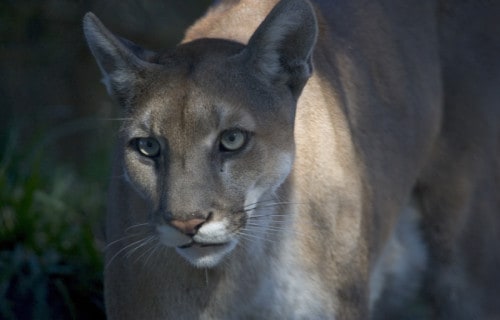
Florida Panther Facts
- Closing out this compendium of 5 Fabulous Mammals of Florida is one that currently appears nowhere else, the aptly-named Florida Panther.
- This majestic product of Nature and evolution most commonly goes by the informative common name due to its range. It also has other general names, though. These include such terms as Florida cougar, Florida Puma, and Coast Rican puma.
- Among scientific professionals, however, it’s better known by its formal moniker. That’s the somewhat different term of Puma concolor cougar. Regardless of the title one chooses to use, it represents a severely threatened subspecies of cougar.
- It received that unique technical name due to the efforts of the American zoologist, Outram Bangs. This researcher accomplished the first known acknowledgement of it as a separate and distinct species. That scientifically noteworthy action occurred in 1899.
- The mammal also represents the only subspecies of cougar in its part of the country it lives in. To the knowledge of wildlife experts, it only occupies about 5% of its former range. Current estimates place its total population at just over 200 individuals.
- Given this sad situation, the IUCN now lists the animal as Critically Endangered. That status is reflected on the organization’s published Red List of Threatened Species. Before protections existed, its numbers once dwindled to only 20 specimens.
- Because of its scant numbers and restricted range, it understandably faces many threats to its existence. Further habitat loss due to human expansion obviously qualifies. Like most species on earth, though, it also now faces the perils of climate change.
Florida Panther Physical Description
The magnificent Florida Panther immediately impresses anyone fortunate enough to view one. Much like its close relatives, it does so due to a combination of factors. One’s its sheer size. Though certainly not as large as some wild felines, it’s nonetheless respectable.
Also following a pattern common to its kin, the animal shows a moderate degree of the physiological trait of sexual dimorphism. In its specific case, though, this trait manifests itself purely in terms of size. In overall appearance, however, the genders appear the same.
Regarding the sheer physical size, though, males most often attain larger growth than their female counterparts. These reach weights equaling up to a respectable 159 lb (72 kg). They also attain a known head-to-tail length that ranges from 5.9 – 7.2 ft (1.8 – 2.2 m).
Females, meanwhile, generally reach moderately shorter lengths. They also develop a somewhat more slendere body shape. This further reduces their mass in comparison with males. Females therefore reach a weight that ranges from between 64 – 100 lb (29 – 45.5 kg).
Otherwise, the sexes of the Florida Panther remain virtually indistinguishable based on patterns of color. At birth, both present a spotted pattern, and striking blue eyes. As they mature, though, the eyes change to a yellowish shade, while the spots disappear entirely.
Among mature adult specimens of the animal, the fur of the upper body takes on a deep tan hue. The underbelly of the gorgeou mammal, though, usually shows a creamy white in color. In contrast, distinctive black markings manifest on the tips of the tail and ears.
- Kingdom: Animalia
- Phylum: Chordata
- Class: Mammalia
- Order: Carnivora
- Family: Felidae
- Genus: Puma
- Species: P. concolor
- Subspecies: P. c. couguar

Florida Panther Distribution, Habitat, and Ecology
The native range of the Florida Panther probably comes as no surprise. That’s due to the simple fact that its very name provides a clear indication of that territory. As that dictates, the animal evolved as native to the state of Florida, in the United States, in North America.
Yet even there, as mentioned previously, it only inhabits a portion of its former range. That consists of the southeastern portion of the state. Records indicate that it once appeared in either all or at least parts of at least 6 other states. It’s unknown if it ever lived beyond that.
This marvel of Nature is highly adapted to its habitat. Unfortunately, though renders it vulnerable in many ways. Its highly limited range now severely limits the simple number of locations it can potentially appear. All of these occur in the southeast portion of Florida.
There, the majestic creature lives almost exclusively in one of three types of ecosystems. These consist of regions of tropical hardwood hammocks, pinelands, or mixed freshwater swamp forests. Luckily, much of its remaining range now lies within protected areas.
Again following a pattern common to wild felines, each individual Florida Panther migrates through its territory. This mainly occurs during the day. Most specimens prefer to spend their days in the wetlands, then move to grassland in the evening. It’s also mainly nocturnal.
Given its feline ancestry, it naturally evolved as carnivorous in nature. Its prey typically consists of a variety of small animals. It will, however, attack larger prey. These typically include such species as deer or wild boar. Alligators comprise its only known natural predator.
5 Fabulous Mammals of Florida
We hope that each of you enjoyed reading, and hopefully learning from, this article we’ve written about these 5 Fabulous Mammals of Florida. It’s also our hope that doing so has left you with either a new or renewed appreciation for such wonders of Nature.
Unfortunately, however, many of their kindred around the world now find themselves facing strong threats to their continued existence as a species. Many of those dangers, in fact, stem from the actions of mankind. We must do all we can to protect and preserve them all.
Check out our other articles on 4 Phenomenal Philippine’s Reptiles, 3 Surprising Sahara Desert Sites, 5 Woefully Rare Wood Shrubs, 5 Incredible Invertebrates of Japan
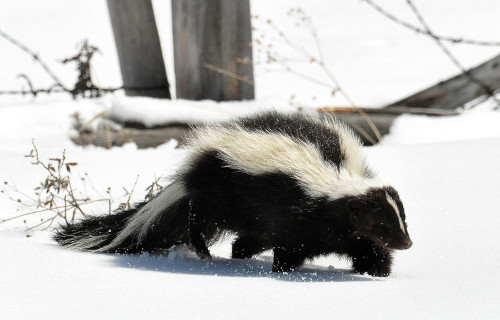

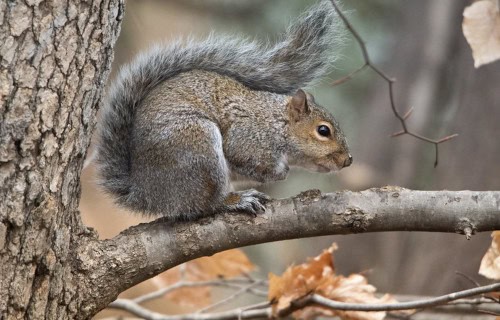
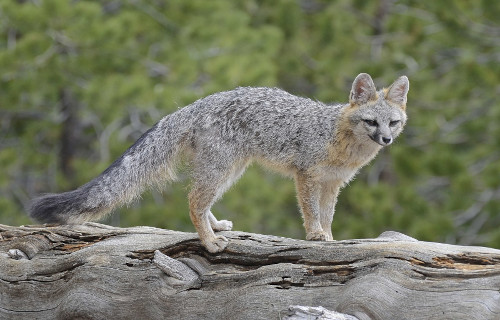

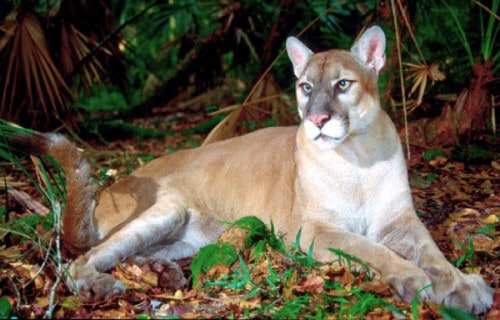









Leave a Reply